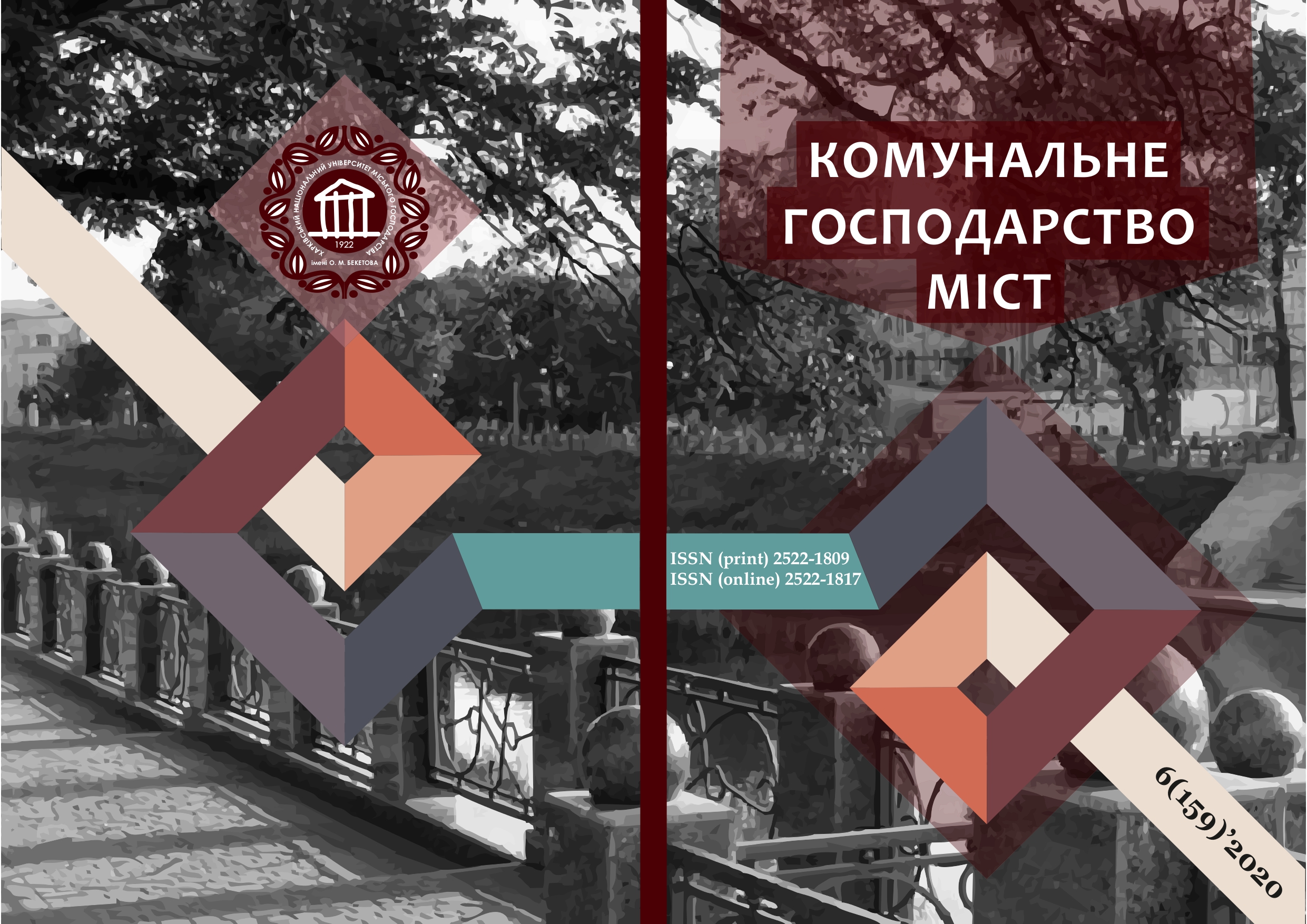«ATYPICAL» PROBLEMS OF URBANISM CLASSIFICATION, CHARACTERISTICS AND APPROACHES TO THE SOLUTION
Array
Keywords:
urban problem, «atypical» problem, spatial planning, requirements and restrictions, conditions, analysis of spa-tial situation, substantiation of project decisionAbstract
In the urban sphere, the problems become more complicated and there are many violations and errors, so the problem of streamlining the problems of urban planning and substantiation of new methodological tools for solving «atypical» problems is relevant, as classical methods are ineffective. In the article the author solved problems: classification, specification of structure and maintenance of urban problems; substantiation of typological features and selection of «atypical» urban problems; outlining the general algorithm and methods of their solution; checks of orderly methodical tools on urban tasks of Lviv.
Existing methods and solutions of urban problems are systematized. The general scientific methods of research include: theoretical (convergence from the abstract to the concrete, the method of formalization, the historical method, the system-structural, the method of studying documents); empirical (method of observation, comparison, field surveys, measurements) and empirical-theoretical (abstraction, analysis, synthesis, logical method, modeling), as well as statistical, historical, sociological and cartographic analysis. The classification and «atypical» problems of urban planning are carried out, the methodical tools of their solution are arranged. Methods and means to increase the efficiency of functioning and development of urban systems are based on the provisions of fuzzy sets and their essence. Thus, the new methods should classify urban problems by input and output indicators and knowledge of the internal structure of the system (processes and behavior). According to the theory of validity, in the first step, data are collected using various methods, denoted by codes, grouped into groups to make them more effective.
Classification and characterization of «atypical» tasks, as well as updated methodological tools were tested on the example of Lviv — the principles and ways of reforming and developing its spatial structure. The forecast of the future is based on the genesis and historical ways of development of territories and cities. New ways or elimination of old ones meet at radical reforms, and development is caused not only by historical longevity and change of conditions, but also by new processes and behavior of system. There are ways to solve «atypical» problems: simple, including one direction; more complex covers the main direction and two or three additional subdirections; complex includes one or two main directions and several subdirections. This substantiates the feasibility of permanent city design and updating of urban planning documentation.
References
2. Weber E.P., Khademian A.M. (2008). Wicked Problems, Knowledge Challenges, and Collaborative Capacity Builders in Network Settings. Public Administration Review. № 68. С. 334–349. (eng)
3. Bauman, Z.(2003). City of Fears, City of Hopes. Gold-smiths College, University of London, рp. 2–39. URL: http://cms.gold.ac.uk/media/city.pdf (eng)
4. Belokon', YU. (2003). Regional'noye planirovaniye (teoriya i praktika). K. : Logos, 259 s. (rus)
5. Vadimov, V.M. (2007). Metodolohiya dosvidu rozrobky ta realizatsiyi pravyl zabudovy mis’kykh terytoriy. Dosvid ta perspektyvy rozvytku mist Ukrayiny. K.: Dipromisto, vyp. 12, s. 172–183. (ukr)
6. Diomin, N. M. (1991). Upravleniye razvitiyem gradostroitel'nykh sistem. K.: Budível'nik, 184 s. (rus.)
7. Dreval’, I.V. (2013). Metodolohichni osnovy mistobudivnoho rozvytku zaliznychnykh vokzal’nykh kompleksiv : avtoref. … d-ra arkhitektury: 08.00.04. Poltava, PNTU im. YU. Kondratyuka, 35 s. (ukr)
8. Lavryk, H.I. (2002). Osnovy systemnoho analizu v arkhitekturnykh doslidzhennyakh i proektuvanni: pidruch. K.: KNUBA, NDPI mistobuduvannya, 348 s. (ukr)
9. Ositnyanko, A. P. (2005). Planuvannya rozvytku mista: monohr. K: KNUBA, 385 s. (ukr)
10. Pleshkanovs’ka, A.M. (2013). Metodolohiya kompleksnoyi rekonstruktsiyi mista: dys. … d-ra tekhn. nauk: 05.23.20, K., KNUBA, 400 s. (ukr)
11. Tymokhin, V. (2014). Problemy i pryntsypy rekonstruktsiyi suchasnoho mis’koho seredovyshcha. Dosvid ta perspektyvy rozvytku mist Ukrayiny. K.: Dipromisto, vyp. 26, s. 15–25. (ukr)
12. Fil'varov, G.I. (2003). Nevozmozhno zhit' v dvadtsat' pervom veke, a stroit' tak, kak v devyatnadtsatom: [Beseda s direktorom Kiyevskogo instituta urbanistiki Fil'varovym G. ; zapisal S. Zakhozhiy]. Budmayster, № 3, s. 4–5. (rus)
13. Shubovich, S.A. (2012). Mifopoeticheskiy fenomen arkhitekturnoy sredy Kh.: KHNAGKH, 178 s. (rus)
14. Osychenko, H.O. (2012). Psykhofizychni vzayemodiyi lyudyny z mis’kym seredovyshchem. Mistobuduvannya ta terytorial’ne planuvannya, vyp. 45(2), s. 71–81. (ukr)
15. Habrel, М. (2017). Analiza problemow przeszczennych Lwowa – podejscie systemowe. Space – Society – Economy. University of Lódź, № 21, s. 63–72. (pol)
16. Habrel, M. (2016). Przestrzenna organizacja systemow urbanistycznych. Podejscie metodologiczne. Lodz : Wydawnictwo University Lodzkiego, 186 s. (pol)
17. Habrel, M., Habrel, M. & Lysiak, N. (2020). Spatial Change of Lviv in the post-Soviet period and their assessment by the Residents. 5th World Multidisciplinary Civil Engineering – Architecture – Urban Planning Symposium WMCAUS 2020, Prague, Czech Republic, 1–5 Sep-tember 2020, p. 139. URL: https://www.wmcaus.org/files/ WMCAUS2020_Book.pdf (eng)
Downloads
Published
How to Cite
Issue
Section
License
The authors who publish in this collection agree with the following terms:
• The authors reserve the right to authorship of their work and give the magazine the right to first publish this work under the terms of license CC BY-NC-ND 4.0 (with the Designation of Authorship - Non-Commercial - Without Derivatives 4.0 International), which allows others to freely distribute the published work with a mandatory reference to the authors of the original work and the first publication of the work in this magazine.
• Authors have the right to make independent extra-exclusive work agreements in the form in which they were published by this magazine (for example, posting work in an electronic repository of an institution or publishing as part of a monograph), provided that the link to the first publication of the work in this journal is maintained. .
• Journal policy allows and encourages the publication of manuscripts on the Internet (for example, in institutions' repositories or on personal websites), both before the publication of this manuscript and during its editorial work, as it contributes to the emergence of productive scientific discussion and positively affects the efficiency and dynamics of the citation of the published work (see The Effect of Open Access).

